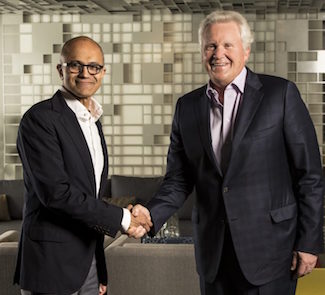GE and Microsoft unveiled a new partnership this week that will make GE’s Predix platform for the Industrial Internet available on Microsoft’s Azure cloud platform.
The move marks the first step in what the companies are calling a “broad strategic collaboration” which will allow joint customers to capture intelligence from their industrial assets and take advantage of Microsoft’s enterprise cloud applications.
GE says it has spent $1 billion to develop Predix, an operating system and platform for building applications that connect to industrial assets, collect and analyze data, and help optimize industrial infrastructure and operations.
 |
| Microsoft CEO Satya Nadella and GE CEO Jeff Immelt announced a partnership that will make GE’s Predix platform for the Industrial Internet available on the Microsoft Azure cloud. (Image Credit: Microsoft) |
“As businesses look to connect their industrial machines from the edge to the cloud, bringing Predix to Azure gives customers greater choice and flexibility to securely harness the power of data from machines and systems of intelligence,” GE says. “Companies worldwide will be able to bridge the divide between the operational and information technologies that make up the Industrial Internet of Things.”
“Connecting industrial machines to the internet through the cloud is a huge step toward simplifying business processes and reimagining how work gets done,” said Jeff Immelt, CEO of GE. “GE is helping its customers extract value from the vast quantities of data coming out of those machines and is building an ecosystem of industry-leading partners like Microsoft that will allow the Industrial Internet to thrive on a global scale.”
GE’s Predix platform is used by industrial organizations to build, deploy and operate industrial applications. “Bringing Predix to Azure means those same customers will now have access to additional capabilities such as natural language technology, artificial intelligence, advanced data visualization and enterprise application integration,” GE and Microsoft claim.
Azure will support the growth of the entire industrial IoT ecosystem by offering Predix customers with data sovereignty, hybrid capabilities, and advanced developer and data services.
“Every industry and every company around the world is being transformed by digital technology,” said Satya Nadella, CEO, Microsoft. “Working with companies like GE, we can reach a new set of customers to help them accelerate their transformation across every line of business — from the factory floor to smart buildings.”
Earlier this year at Hannover Messe,the world’s largest industrial manufacturing conference, Microsoft further staked its claim for the cloud-based IIoT. At Hanover, it announced that “device management features for Azure IoT Hub will be broadly available in public preview, and the new Azure IoT Gateway SDK will be available in beta.” A few weeks earlier, at Build 2016, Microsoft announced Azure IoT Gateway SDK and device management in Azure IoT Hub.
But while there are many use cases where third-party cloud-controlled IIoT is beneficial, there are others that are not so clear-cut. Cesare Garlati, the chief security strategist for the Prpl Foundation (and also co-chair of the Cloud Security Alliance’s mobile working group) has some concerns. Prpl Foundation, a community-driven consortium focusing on the MIPS architecture and ecosystem, has a strong interest in the IoT. In January this year Prpl published ‘Security Guidance for Critical Areas of Embedded Computing’. At its heart, the IoT is basically embedded systems with some connectivity.
One of Garlati’s primary concerns is the security of IoT in general. In the consumer world, there is little choice but to use what is available even when the supplier’s business case rests on locking the customer into specific products. Revolv is an example of his concerns. In February the company quietly announced, “As of May 15, 2016, your Revolv hub and app will no longer work.” That simply means that all devices bought for and currently running via the Revolv Hub will simply stop working – and there is nothing that the people who bought and own these devices can do about it.
While this is an inconvenience to people, it is not a threat to businesses. But the principle remains the same for the IIoT. “Why would you want t
o control your factory from Azure in the cloud when you can already control it from within your own factory?” Garlati asked in a previous telephone interview with SecurityWeek.
“If you have a relatively small amount of sensors and embedded devices concentrated in a small area, that is, your plant, then you almost certainly already have a local network. You can interconnect the devices to come up with a private network for your embedded devices. It might well use the internet, but it is controlled and operated by one single company; usually the plant owner. Why would you go onto the public internet and rely on a third party service provider?”
Predix on Azure is scheduled to be commercially available by the second quarter of 2017, and developer preview will be released toward the end of 2016.
In addition, GE and Microsoft plan to integrate Predix with Azure IoT Suite and Cortana Intelligence Suite along with Microsoft business applications, such as Office 365, Dynamics 365 and Power BI, in order to connect industrial data with business processes and analytics.
Related: Learn More At SecurityWeek’s 2016 ICS Cyber Security Conference
Kevin Townsend contributed to this report

















